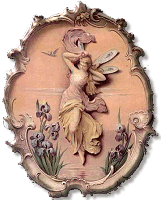
Interestingly, in the Middle Ages, the Church denounced everything and anything “eastern” as the “devil’s work” which meant drug addiction was extremely rare. Monks coming back from the Crusades found new uses in how to use drugs in helping the sick, but it would seem that was as far as it went.
The Victorian Era, however, had major problems with rampant drug abuse and alcoholism. Drugs like heroin, chloral, and laudanum were available and widely prescribed. The rapidly expanding British Empire brought drugs used from other lands into the country and, as a result, to the USA.
 Common Drugs
Common DrugsLaudanum — a mixture of alcohol and opium derivatives ... common item included in the medicine kits of many proper Victorian families
Alcohol was easily produced and distributed ... these beverages were used to alleviate a host of ailments ... epilepsy, gout, kidney stones, colic, fever, headaches
The high use of barbiturates and depressants may indicate difficulties coping with the rigid social order.
OPIUM
1839: Opium Deaths
Opium and its preparations are responsible for more premature deaths than any other chemical agent. Opiates account for 186 of 543 poisonings, including no fewer than 72 among children.
18 March 1839: First Opium War
Lin Tse-Hsu, imperial Chinese commissioner in charge of suppressing the opium traffic, orders all foreign traders to surrender their opium. In response, the British send expeditionary warships to the coast of China, beginning The First Opium War.

1840: New England Imports Opium
New Englanders bring 24,000 pounds of opium into USA. US Customs promptly put a duty fee on the import
1856: Second Opium War
Britain & France win. Opium production increases.
HEROIN
.[source: http://drugs.uta.edu/drugs.html] ...
Heroin was a brand name coined for the bonding of morphine, opium's active ingredient, with acetic anhydride, a common industrial acid. The name was supposed to refer to the heroic, fearless and painless, sensation users felt after using it. It was discovered by a British chemist in 1874, and first mass produced by German pharmaceutical Bayer in 1898.
Drug abuse and drug problems were blamed on foreigners.
Be sure to check out ...
This site is dedicated to an investigation of the uses and abuses of drugs and alcohol within Victorian society. In particular, it investigates the role of drug and alcohol use in the production of art and literature and how drug and alcohol use gets represented in the literature and art of the period.

Famous Victorian Drug Addicts
• Elizabeth Eleanor Siddal (1829–1862) = British model, poet, artist = addicted to laudanum ... 1st PG stillborn due to addiction ... 2nd PG Siddal overdosed ... Rossetti found her unconscious and dying in bed ... some say she left a suicide note that the doctor told Rossetti to burn
• poet & painter Dante Gabriel Rossetti (1828-1882) addicted to chloral hydrate
• Elizabeth Barrett Browning (1806-1861) = lifelong addict
 (started in childhood to treat spinal tuberculosis) ... had miscarriage because of abuse
(started in childhood to treat spinal tuberculosis) ... had miscarriage because of abuse• Samuel Coleridge (1875-1912) ... addicted to laudanum most of life ... the Royal Institute commissioned Coleridge to give a series of lectures in London... his use of opium caused him to cancel scheduled appearances
• Percy Bysshe Shelley (1792-1822) suffered raging laudanum-induced hallucinations
• John Keats (1795-1821) suffered from cocaine, heroin, alcohol addiction
• Lewis Carroll (1832-1898) some say the inspiration of Alice in Wonderland came from his substance abuse hallucinations
• laudanum addict = novelist Charles Dickens (1812-1870)
• laudanum addict = novelist Wilkie Collins (1824-1889)
• Charles Tennyson (brother of Alfred Tennyson) was an opium addict (his poem Silkworms and Spiders alludes to his addiction)

• some say Oscar Wilde abused opium as depicted in the decadent life-style in The Picture of Dorian Gray
• Edgar Allan Poe (1809-1849) suffered from opium and alcohol addiction
• Mary Todd Lincoln (1818-1882) ... misprescribed laudanum for sleep problems ... it caused anxiety & hallucinations ... because she experienced an increase of hallucinations, she was prescribed more laudanum & chloral hydrate which increased the problem leading to her eventual commitment to an asylum
• The Average Joesphine ... laudanum prescribed for menstrual cramp relief and vague aches ... spoon fed to infants
• 1883: J. B. Mattison (American doctor) suggested 30%-40% of American doctors were addicted
[Source: Morphine-Addicted Doctors, The English Opium-Eater, & Embattled Medical Authority by Barry Milligan of Wright State University, 2005, Cambridge Journal, Cambridge University Press)
~ From the notes of Lady Victorian Historian



